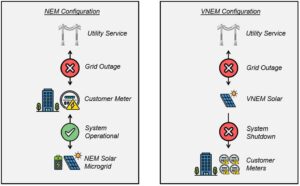
Senate Bill 1148: Enabling resilience through Master Metering
This blog post explains why the Clean Coalition is facilitating SB 1148.
SB 1148: Enabling resilience through Master Metering at multi-unit housing, government institutions (including schools), and places of worship.
Why is the Clean Coalition facilitating SB 1148 (Blakespear and Wahab)?
California’s legislative mandate of 100% renewable energy and electrification by 2045 will require significant amounts of new fully-electric housing and retrofits to the existing housing stock. In a future of increased reliance on electricity, the guarantee of uninterrupted electrical services is crucial. When fully electrified, a grid outage can mean the loss of essential public services (and potentially even lives), if there is no backup power available. Furthermore, in the face of rapid climate change, extreme weather events, and severe wildfires, the need for resilient electricity takes on added importance. A significant barrier to renewables-driven energy resilience is the existing requirement that treats multi-family housing differently from single-family housing due to the use of multiple utility meters versus a single utility meter. Single-family homes can achieve resilience through a Solar Microgrid deployment; multi-family homes cannot.
As per the Public Utilities Code Section 780.5, any residential unit in an apartment complex, condominium, or mobile home park built after July 1, 1982, must be individually metered for electricity and gas service, excluding certain exemptions for housing provided by postsecondary educational institutions or for farmworker. While unintentional, this code creates significant barriers to resilience at multi-unit facilities that make microgrid deployments complicated, costly, and resource intensive for all parties involved. Because there is no existing standard pathway for resilience across the IOU service territories, multi-unit housing facilities are completely without power when grid outages occur. Schools and local government facilities are also often required to deploy separate meters, limiting the opportunity for resilience.
Microgrids are able to electrically disconnect from the broader distribution grid, allowing the area within the microgrid to continue functioning via onsite renewable generation, energy storage, and monitoring & control solutions, even during grid outages. As California’s aging grid becomes more vulnerable to a myriad of potential threats and the consequences from each outage increase, microgrids are an effective pathway to ensure a trifecta of environmental, economic, and resilience benefits are realized by all Californians.
In the case of single family homes, resilience can be deployed through a standard Solar Microgrid – also called a behind-the-meter (BTM) microgrid – using the Net Energy Metering (NEM) program. These projects can typically be completed within a year, which is just one of the reasons that there are many Solar Microgrids deployed throughout California. In contrast, multi-unit housing facilities face unique resilience challenges due to the existing requirement that each unit be individually metered and solar must be directly connected to the utility grid – front-of-meter (FOM) – via the virtual net energy metering (VNEM) program. With so many connections to the grid and solar deployed FOM, the only option for resilience is a Community Microgrid.
A Community Microgrid is a system deployed on the local distribution grid that integrates multiple distributed energy resources (DER) on both sides of the customer meters, including generation and battery storage, capable of providing electricity to multiple facilities or a community. Solar microgrids provide resilience to a single facility; Community Microgrids deliver renewables-driven resilience to an entire section of the distribution grid. However, to date, very few Community Microgrids have come online in California because they are very complicated and resource-intensive to deploy and the needed regulatory framework is still under development. The Clean Coalition believes that Community Microgrids are a crucial component of the grid of the future that is decentralized, bi-directional, flexible, and resilient. We will continue to work on policy that helps unlock that future. Solar Microgrids are a key building block of Community Microgrids; enabling deployments at multi-unit housing sites will benefit the residents, the ratepayers, and help modernize the grid.
SB 1148 allows the use of a single “master meter” that serves as the point of connection between the site and the distribution grid, making BTM renewables-driven resilience possible. See the example of a Solar Microgrid deployed at a master metered site below. Master metering leverages a centralized metering system to monitor, manage, and optimize energy use across buildings, entire sites, campuses, or communities. This approach replaces individual utility revenue meters with a single “master meter” tracking the total energy consumption of all units within the complex.

In addition to the master meter, a private sub-meter can be installed for each unit, preserving incentives for energy efficiency and conservation, guaranteeing accurate billing, and preventing consumer protection violations. A master meter with private sub meters will provide greater visibility, control, and coordination of on-site energy use and generation in a way that enhances energy resilience. This leads to an energy system that is efficient, sustainable and resilient.
The following diagrams illustrate the contrasting configurations of NEM and VNEM systems during normal grid operations and grid outages:
NEM & VNEM Configuration Differences During Normal Grid Operations

NEM & VNEM Configuration Differences During A Grid Outage (resilience)

The core issue lies in the configuration of VNEM systems. VNEM, commonly used for solar installations at multi-unit housing, operates FOM with a direct connection to the grid. Energy produced by the VNEM system uses distribution infrastructure before serving loads on-site at the site. During outages, utilities do not allow non-utility entities to operate sections of the distribution grid and the solar automatically turns off. Even if a site is allowed to operate a section of the grid, permitted through programs such as PG&E’s Community Microgrid Enablement Tariff (CMET), further obstacles exist:
- Meter control: Utilities like currently do not allow non-entities to manage meters during outages. A site cannot use energy that will “spin” the utility revenue meters, preventing independent power distribution even with local generation.
- Load separation: Current VNEM rules prevent any loads from operating behind the residential meters (“Benefitting Accounts”) or the meter with the solar+storage system (“Generating Account”) during a power outage. This vague and impractical language is likely not technically feasible given the current technologies approved by the utilities, hindering the potential of microgrids that enhance resilience and enable smart usage of the grid.
While workarounds using solar connections might be explored, these approaches remain largely infeasible in investor-owned utility service territories (San Diego Gas & Electric, Southern California Edison, and Pacific Gas & Electric) due to standardization and regulatory limitations.
Therefore, provisioning resilience at multi-meter sites requires passing SB 1148, to allow master metering and private submetering at multi-unit housing and master metering at government facilities (including schools) and places of worship.
Master metering at multi-unit housing offers benefits for both residents and ratepayers. Residents will receive lower electricity bills and renewables-driven resilience for critical loads during outages. These benefits are particularly important for multi-unit housing rented by socio-economically disadvantaged Californians and/or located in vulnerable communities. For the ratepayers, master metering reduces connection points to the grid and billing arrangements, helps unclog interconnection queues, and contributes to grid resilience. Local energy also helps to reduce the amount of new transmission infrastructure needed, increasing the affordability of rates for all. Moreover, master metering will reduce development costs at multi-unit housing sites by reducing electrical design timelines and conserving space (rooms that would have been dedicated to housing electrical meters can instead be used as extra apartments), making them more affordable for low-income populations while aiding the implementation of local electrification mandates. Master metering at government institutions, schools, and places of worship will preserve key community hubs, emergency shelter sites, and crucial services during outages.
Master metering enables on-site energy management that prioritizes efficiency, reliability, and intelligent usage of the grid, ultimately contributing to the development of more resilient and adaptive energy systems. Because non-utility entities are not permitted to operate a portion of the utility’s grid, deploying FOM DER is impractical for resilience at multi-unit housing facilities. Allowing usage of a master meter and BTM DER enables resilience, site-level management of energy, optimized usage of electric vehicles (EV) and EV charging infrastructure, and efficient grid usage. As the state transitions to net zero, master metering ensures all California residents continue to have power even in the face of power outages and save money in the process, paving the way for a renewables-driven and grid resilient future.

